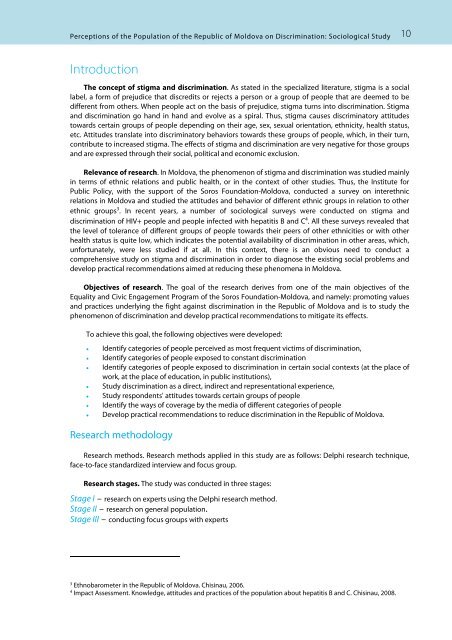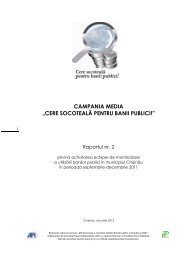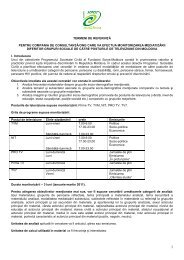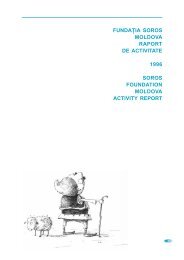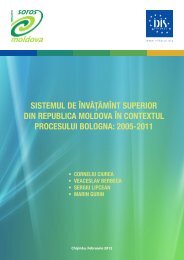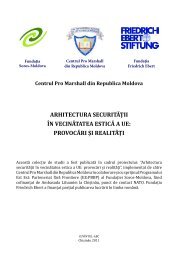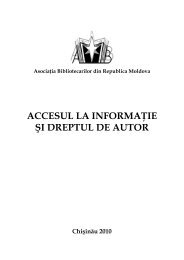Perceptions of the Population of the Republic of Moldova - Soros ...
Perceptions of the Population of the Republic of Moldova - Soros ...
Perceptions of the Population of the Republic of Moldova - Soros ...
- No tags were found...
Create successful ePaper yourself
Turn your PDF publications into a flip-book with our unique Google optimized e-Paper software.
<strong>Perceptions</strong> <strong>of</strong> <strong>the</strong> <strong>Population</strong> <strong>of</strong> <strong>the</strong> <strong>Republic</strong> <strong>of</strong> <strong>Moldova</strong> on Discrimination: Sociological Study 10IntroductionThe concept <strong>of</strong> stigma and discrimination. As stated in <strong>the</strong> specialized literature, stigma is a sociallabel, a form <strong>of</strong> prejudice that discredits or rejects a person or a group <strong>of</strong> people that are deemed to bedifferent from o<strong>the</strong>rs. When people act on <strong>the</strong> basis <strong>of</strong> prejudice, stigma turns into discrimination. Stigmaand discrimination go hand in hand and evolve as a spiral. Thus, stigma causes discriminatory attitudestowards certain groups <strong>of</strong> people depending on <strong>the</strong>ir age, sex, sexual orientation, ethnicity, health status,etc. Attitudes translate into discriminatory behaviors towards <strong>the</strong>se groups <strong>of</strong> people, which, in <strong>the</strong>ir turn,contribute to increased stigma. The effects <strong>of</strong> stigma and discrimination are very negative for those groupsand are expressed through <strong>the</strong>ir social, political and economic exclusion.Relevance <strong>of</strong> research. In <strong>Moldova</strong>, <strong>the</strong> phenomenon <strong>of</strong> stigma and discrimination was studied mainlyin terms <strong>of</strong> ethnic relations and public health, or in <strong>the</strong> context <strong>of</strong> o<strong>the</strong>r studies. Thus, <strong>the</strong> Institute forPublic Policy, with <strong>the</strong> support <strong>of</strong> <strong>the</strong> <strong>Soros</strong> Foundation-<strong>Moldova</strong>, conducted a survey on interethnicrelations in <strong>Moldova</strong> and studied <strong>the</strong> attitudes and behavior <strong>of</strong> different ethnic groups in relation to o<strong>the</strong>rethnic groups 3 . In recent years, a number <strong>of</strong> sociological surveys were conducted on stigma anddiscrimination <strong>of</strong> HIV+ people and people infected with hepatitis B and C 4 . All <strong>the</strong>se surveys revealed that<strong>the</strong> level <strong>of</strong> tolerance <strong>of</strong> different groups <strong>of</strong> people towards <strong>the</strong>ir peers <strong>of</strong> o<strong>the</strong>r ethnicities or with o<strong>the</strong>rhealth status is quite low, which indicates <strong>the</strong> potential availability <strong>of</strong> discrimination in o<strong>the</strong>r areas, which,unfortunately, were less studied if at all. In this context, <strong>the</strong>re is an obvious need to conduct acomprehensive study on stigma and discrimination in order to diagnose <strong>the</strong> existing social problems anddevelop practical recommendations aimed at reducing <strong>the</strong>se phenomena in <strong>Moldova</strong>.Objectives <strong>of</strong> research. The goal <strong>of</strong> <strong>the</strong> research derives from one <strong>of</strong> <strong>the</strong> main objectives <strong>of</strong> <strong>the</strong>Equality and Civic Engagement Program <strong>of</strong> <strong>the</strong> <strong>Soros</strong> Foundation-<strong>Moldova</strong>, and namely: promoting valuesand practices underlying <strong>the</strong> fight against discrimination in <strong>the</strong> <strong>Republic</strong> <strong>of</strong> <strong>Moldova</strong> and is to study <strong>the</strong>phenomenon <strong>of</strong> discrimination and develop practical recommendations to mitigate its effects.To achieve this goal, <strong>the</strong> following objectives were developed:• Identify categories <strong>of</strong> people perceived as most frequent victims <strong>of</strong> discrimination,• Identify categories <strong>of</strong> people exposed to constant discrimination• Identify categories <strong>of</strong> people exposed to discrimination in certain social contexts (at <strong>the</strong> place <strong>of</strong>work, at <strong>the</strong> place <strong>of</strong> education, in public institutions),• Study discrimination as a direct, indirect and representational experience,• Study respondents' attitudes towards certain groups <strong>of</strong> people• Identify <strong>the</strong> ways <strong>of</strong> coverage by <strong>the</strong> media <strong>of</strong> different categories <strong>of</strong> people• Develop practical recommendations to reduce discrimination in <strong>the</strong> <strong>Republic</strong> <strong>of</strong> <strong>Moldova</strong>.Research methodologyResearch methods. Research methods applied in this study are as follows: Delphi research technique,face-to-face standardized interview and focus group.Research stages. The study was conducted in three stages:Stage I – research on experts using <strong>the</strong> Delphi research method.Stage II – research on general population.Stage III – conducting focus groups with experts3Ethnobarometer in <strong>the</strong> <strong>Republic</strong> <strong>of</strong> <strong>Moldova</strong>. Chisinau, 2006.4Impact Assessment. Knowledge, attitudes and practices <strong>of</strong> <strong>the</strong> population about hepatitis B and C. Chisinau, 2008.


